The Jewish Traveler
Feature
Kochi, an Ancient Jewish Treasure in South India
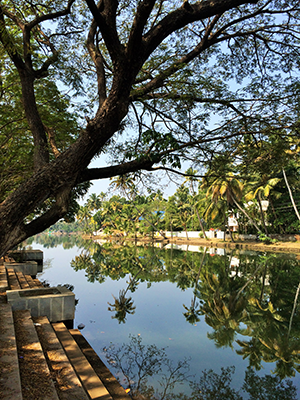
The unassuming slate-gray sign spells out Jew Town Road in block-white English letters and round Malayalam script. To Western visitors to South India, the name might sound offensive or discriminatory, but in Kochi—historically known as Cochin—Jew Town is an emblem of autonomy, the proud label of a Jewish community that for centuries lived alongside its Hindu neighbors.
Kochi is located in the state of Kerala, famous for its beaches, lagoons and lush backwaters as well as its social advancement: 100 percent literacy and the lowest infant mortality and highest life expectancy rates in India. The port city of 2.1 million includes the barrier islands of Fort Kochi and Mattancherry as well as the mainland of Ernakulam. Today, just 26 Jews call Kochi home.
Kochi’s fabled Jewish history is the source of much debate, both in the community and among scholars. One tradition claims that Jews arrived in the time of King Solomon, traders in gold, ivory, spices and peacock feathers. Another posits that the first Jews arrived in Cranganore, 25 miles north of Kochi, in the first century CE, after the destruction of the Second Temple. The only Indian seaport known to the outside world at that time, Cranganore was called Shingly by the Jews and Muziris by the Romans and Greeks.
After the destruction of Cranganore in the early 14th century, a few survivors escaped to Kochi, where the maharaja granted the Jews a large piece of land adjoining his palace. In fact, Mattancherry, a combination of Hebrew and Malayalam, means gift of land.
Jews fleeing the spanish inquisition in the early 16th century also reached Kochi, followed by immigrants from Baghdad, Yemen and other parts of the Middle East. The newcomers, called paradesis (foreigners), constructed their own synagogue in 1568 just 30 yards from the maharaja’s palace. The Kochi community was held in such high regard that the Indian government issued a commemorative stamp on the synagogue’s 400th anniversary.
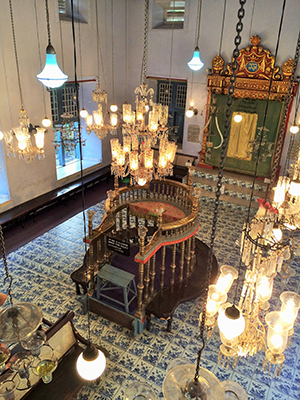
The Dutch battled the Portuguese for control of Kochi in the mid-1600s but were initially defeated. The Jewish mercantile community allied itself with the Dutch East India Company, which had set up shop in Kochi to export pepper, then more valuable than gold. The Portuguese carried out reprisals against the Jews, burning the synagogues and sacking Jew Town. When the Dutch finally defeated the Portuguese in 1663, the Jews rebuilt their synagogues and became a highly respected minority. They enjoyed civil and religious liberty for 132 years of Dutch rule.
Some of the most esteemed Jews at this time were philanthropists Ezekiel Rahabi and Isaac Sargun. Rahabi, principal merchant for the Dutch East India Company, “discovered” the Bene Israel in the villages off the coast of Bombay (today, Mumbai) centuries after a shipwreck left the community stranded and with only remnants of Jewish observance.
Kochi’s Jews also flourished under the British, whose rule began in 1795. Iraqi merchant Samuel Koder ran the Cochin Electric Company and owned a chain of department stores. He was also honorary consul to the Netherlands and organized a Freemasons’ group.
At its height in the mid-20th century, Kochi’s Jewish population numbered about 2,000, with eight synagogues in Mattancherry and the surrounding communities. Some of the synagogues bear the same names since they were named after the geographic locations of the original Cranganore synagogues—Kadavambagam (“by the shore”) and Tekkumbagam (“southern side”).
Within five years of Indian independence in 1947, the Indian government liquidated the rule of hundreds of maharajas all over the country to unify the new state. The Jewish Agency for Israel became active in India and, like much of the country’s Jewish population, most Kochi Jews made aliyah in the 1950s. They were largely resettled in five moshavim: Nevatim in the Negev; Aviezer, Mesilat Zion and Taoz near Jerusalem; and Kfar Yuval in the Galilee.
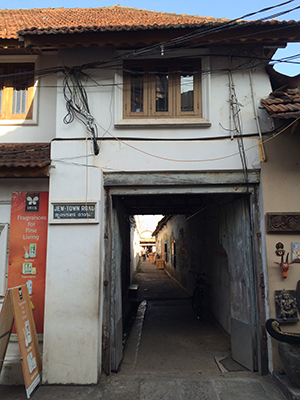
WHAT TO SEE
Jew Town
The neighborhood was once lined with Jewish homes and shops that are now mostly owned by Muslims. Some of the wrought-iron windows and outer walls retain their Star of David decorations, some side by side with swastikas, the Indian good-luck symbol that the Nazis co-opted. Souvenir and antique shops beckon with names like Café Jew Town and Shalom. A.B. Salem Street, which leads to the cemetery, is padlocked behind a gate. The street is named for a community leader, lawyer, teacher and follower of Mahatma Gandhi.
Paradesi Synagogue
Synagogue Lane dead-ends at the resplendent Paradesi synagogue, a whitewashed building with a gabled clay-tile roof designed with Dutch, Portuguese and Indian architectural elements. The square three-story clock tower added in 1761 has three dials: Facing the maharaja’s palace, the characters are Malayalam; viewed from Jew Town, they are Roman; and from the synagogue side, Hebrew letters are used. The synagogue holds services on High Holidays and sometimes on Shabbat during the tourist season, when there are enough Jews for a minyan.
Visitors must remove their footwear before entering the synagogue, perhaps to emulate Hindu and Muslim practice, or perhaps to protect the 1,100 hand-painted blue-and-white Chinese floor tiles. The sanctuary is an intimate palace of light and glass, adorned with Belgian crystal chandeliers and a row of clear, red, green and blue lanterns. Each of the square panels on the gridded ceiling features a lotus pattern. A lyre-shaped tebah (bimah) encircled by brass poles graces the center like a throne, surrounded by benches. It faces the gilded teak Ark, stained red and green, that holds Torah scrolls encased in silver with crowns of gold (one of the crowns was a gift from the maharaja in 1803). A staircase leads to a second tebah—a rarity—from which the Torah and haftarah are read. The women’s balcony, also on the second floor, is accessible from a separate staircase in an anteroom. Women sat behind the reader’s table, entitling them to a better view of the Shabbat Torah reading than the men had.
Two of the five members of the Paradesi community who still live on Synagogue Lane include Queenie Hallegua, granddaughter of Samuel Koder and now the synagogue’s proud warden, and the nonagenarian Sarah Cohen, in whose home visitors can purchase embroidered Judaica and textiles.
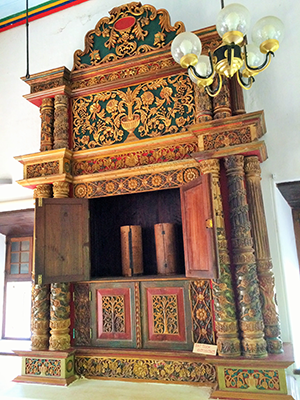
Tomb of Nehemia Mota
The resting place of the Yemenite-born scholar known as the Cochin Kabbalist is not in the cemetery but on a narrow side street off Synagogue Lane—also called Jew Street. After his death in 1615, stories of his miraculous deeds circulated in the community, including one stating that he could fly through the air to reach home in time for Shabbat prayers. The tomb has become a sacred pilgrimage site for locals of all religions. It has been painted aqua and white, its Hebrew inscription and crown daubed a saffron color.
Kadavambagam Synagogue
In a most unlikely setting, the Kadavambagam synagogue in Ernakulam (a 45-minute drive away from Jew Town) sits in the midst of a crowded market, hidden behind a plant and aquarium shop called Cochin Blossoms that incorporates hamsas on its sign. Shopkeeper and synagogue guardian Elias “Babu” Josephai gladly shows visitors around the synagogue. Though in disrepair, its two tebahs, teak Ark and lotus-pattern ceiling retain their beauty. A five-minute walk away, on yet another Jew Street, the Tekkumbagam, or Yellow synagogue (built in the 1930s on a 16th-century site), is currently closed to visitors.
Day Trips
Visit the restored synagogues of Parur and Chendamangalam by private car, taxi, ferry or bus, in a little over an hour north from Kochi or Ernakulam. The Muziris Heritage Project, sponsored by the State of Kerala with the support of the Indian government, has restored the synagogues in both towns as public museums.
The Parur synagogue is the largest, most architecturally distinctive of Kerala’s synagogues. Its bright white façade features four pairs of columns set in front of a second-floor balcony. Beyond the inscription stone, a corridor lined with two rows of facing pillars and a set of arched wooden doorways leads straight to the Ark. The museum is well marked with explanatory signage, videos and even a reproduction of a set of ninth-century copper plates granting land and other privileges to Syrian Christians. The land grant was witnessed by residents of different religions, including four Jews who signed their names in Hebrew.
Further down the street, twin stone pillars that once prevented traffic from entering Parur’s Jew Town on Shabbat have been restored. Visit the nearby outdoor market for a taste of how Jews engaged in the spice trade may have sold their wares.
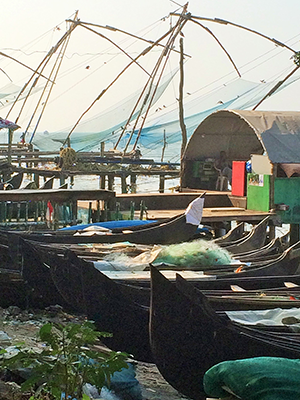
In front of the Chendamangalam synagogue, a blackened pentagonal tombstone from 1268 memorializing a woman named Sarah represents the oldest Hebrew text in the region. The smallest of Kerala’s synagogues, Chendamangalam was built in 1565, restored in 1936, then left to deteriorate once again until it was reopened in 2006.
IF YOU GO
The best time to travel is between November and March, when temperatures average a low of 70 and a high of 90.
The top hotels in the area are the Vivanta by Taj-Malabar, a 30-minute drive from Mattancherry, and Brunton Boatyard in Fort Kochi, a 30-minute walk from Jew Town. Both offer vegetarian selections in their buffets.
Also in Fort Kochi, Koder House is a three-story red-brick boutique hotel on Tower Road a few steps from the graceful Chinese fishing nets, the beach and St. Francis Church—former burial site of Portuguese explorer Vasco da Gama. As the one-time Koder residence, the building once welcomed dignitaries from around the world. Photographs of members of the Koder family with former Prime Minister Indira Gandhi and Queen Elizabeth hang in the hotel’s Menorah Restaurant, which serves Continental, Indian, regional Kerala and Jewish specialties, many vegetarian. The rooms retain some original furnishings.
BTH Sarovaram, a budget hotel in Maradu, a 30-minute drive from Mattancherry, houses a restaurant that serves vegetarian Kerala specialties on banana leaves.
The website cochinsyn.com features comprehensive historical and visiting information about the area’s synagogues.
For Jewish tours, consult jewishindiatours.com. A good resource for general travel information is keralatourism.org.
Rahel Musleah, a frequent contributor to Hadassah Magazine, runs Jewish tours to India and speaks about the communities.










 Facebook
Facebook Instagram
Instagram Twitter
Twitter
Isaac Ashkenazy says
An interesting read and well written compilation of Kochi and the Kerala Jews, with valuable tourist info that i’ll use in my long overdue visit to Kerala. Thanks
cijoy says
India was among few countries in which Jewish community did not have to endure antisemitism Jews has contributed much to the development of Kochin the Queen of Arabian sea , the financial capital of Kerala though other synagogues has been deteriorated paradesi synagogue is still visited by many and is a greate tourist attraction
P Zucker says
If you are interested in a photographic view of the Jewish community of Cochin, I would recommend contacting Joshua Cogan, an Emmy award winning photographer, Hadassah Associate, who chronicled the community in 2003. The images are profound and powerful.